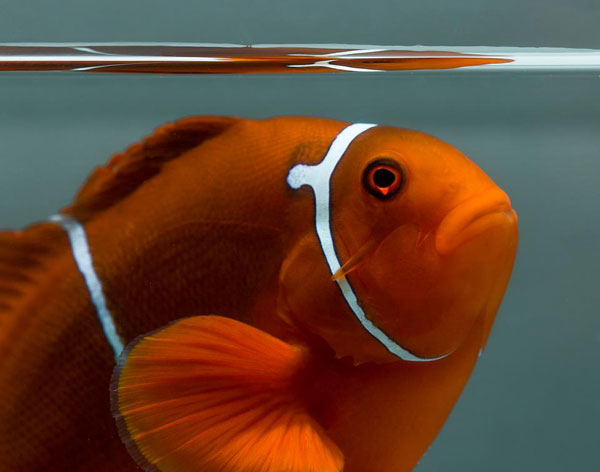AGA Aquascape Winners 2012
15 Feb, 2013

CRIMSON TIDE: A 48-gallon (182-L) tank created by Sim Kian Hong. (Detail. Full aquascape shown below.)
Amazing Underwater Gardens
By Karen Randall
Excerpt from AMAZONAS Magazine, March/April 2013
The Aquatic Gardeners Association Aquascaping Contest is the world’s oldest contest of its kind. This was our 13th year, and I have been privileged to judge both this contest and the Aqua Design Amano IAPLC from the inception. Over the last 13 years we have seen a tremendous growth of interest in aquatic gardening both in the U.S. and worldwide. One of the nice things about our AGA contest is that anyone can go onto our website, www.aquatic-gardeners.org, and see every tank ever entered, including all the details on the tanks and the judges’ comments.
In the United States we come from a long, organized hobby tradition of fish keepers/breeders. It is often easier to teach a new hobbyist how to set up and manage a planted aquarium than it is to “unteach” much of what experienced fishkeepers take as gospel. (Fishrooms run on powerful air compressors just don’t work for planted aquaria!) In North America, most of us live in areas with ready access to the outdoors—yards and gardens to feed our “natural souls.” In many Asian cities, however, most people live in small apartments with no outdoor space.
I suspect it is very tempting to have a little slice of nature in the apartment.
As to why we don’t see more North American winners in the major aquascaping contests, I think fewer Americans and Canadians are willing to constantly ’scape, tear down, and re-scape a tank just for the sake of entering contests. Personally, I value long-term aquascapes that are beautiful for a number of years. But these tanks with longevity are not the ones that typically garner the highest honors in aquascaping contests. Remember, also, how many tanks are entered in these contests. A tank can be very, very good and still not win a prize. Many of these tanks would be astoundingly beautiful if seen by themselves in the owners’ homes. I regularly remind people: Aquascape for yourself. You are the person who needs to live with the tank!
I am very excited about the growth of interest and knowledge I see in the world of aquatic gardening. It is easier than ever to get the equipment and plants you need and the information to do it right. There is help in stores, books, on the Internet, and from members of local aquarium clubs. There are also small, local aquatic gardening clubs springing up everywhere. So if you don’t belong to one yet, find one and join it—and enter an aquascaping contest!
—Karen Randall

©2012 Zhang Jian Feng
“Rainforest”
Larry Lampert Most Innovative Award / Aquatic Garden, 200–320-L category
Zhang Jian Feng
Macau, China
Aquascape Details:
Tank Size: 120 x 50 x 50 cm (47 x 20 x 20 in)
Volume: 210 L (56 gallons)
Lighting: 4 40-W
Plants: Riccardia chamaedryfolia, Marsilea quadrifolia Linn., Myriophyllum mattogrossense
Judges’ Comments:
Karen Randall: I absolutely love this tank…There’s nothing else to say!
Kris Weinhold: Incredible scene—a perfect picture out of the rainforest. You’ve taken the treescape, upped the ante, and produced a forestscape. Well done!
Bailin Shaw: Very well-made trees incorporated into an aquascape that has depth and balance. The river running through the aquascape is very nicely defined and the hatchetfish are an excellent choice for this aquascape—they appear to fly in the tank! Good job!
Click for additional views of “Rainforest” on the 2012 AGA Contest website.

©2012 Hong Te Syu
“SPRING”
Aquatic Garden, Under 28-L category
Hong Te Syu
Ji’an Township, Hualien County
Taiwan, R.O.C.
Aquascape Details:
Tank Size: 36 x 22 x 26 cm (14 x 8.7 x 10 in)
Volume: 20 L (5 gallons)
Plants: Eleocharis sp., Hemianthus callitrichoides, Java Moss, Taxiphyllum barbieri. Treetops: unidentified, but possibly Christmas Moss, Vesicularia montagnei or the very similar Triangle Moss.
Judges’ Comments:
Karen Randall: I can’t quite decide whether I like this tank or not. I am thinking it must be
a maintenance nightmare with all those vertically placed sticks!
Kris Weinhold: Very serene forestscape, particularly given that this is just a 5-gallon aquarium. The mossy treetops might be slightly too thick, but overall it’s very nicely executed.
Luis Navarro: Congratulations, your layout is great.
Bailin Shaw: Stunning tank with excellent use of rocks, roots, and plants to create depth.
The stick that lies across the middle of the tank is not needed and detracts from the
overall effect. Very well done!
Click for additional views of “Spring” on the 2012 AGA Contenst Website

©2012 Prociuk Mikola
“On the Edge of the World”
Aquatic Garden, 60–120-L category
Prociuk Mikola
Kalush Iwano-Frankiwsk, Ukraine
Website: Aquafanat, www.aquafanat.com.ua/forum/index.php
Aquascape Details:
Tank Size: 60 x 40 x 30 cm (24 x 16 x 12 in)
Volume: 72 L (19 gallons)
Background: White film
Lighting: SunSun HDD600
Filtration: SunSun HBL-701 II
Plants: Aegagropila linnaei, Eleocharis “parvula”
Fishes/animals: Hemigrammus rhodostomus, Neocaridina sp. “Red Cherry”
Decorative materials: Substrate Hagen 1–2 mm and mountain stone
Judges’ Comments:
Karen Randall: The rockwork is very nice. While the Aegagropila is interesting, there is SO much of it that it makes things look rather flat. I’d like to see a LITTLE more variety in the plants.
Kris Weinhold: Very creative use of algal Aegragopila in an aquascape.
Bailin Shaw: The arrangement of your hardscape is expertly done and the use of the Aegagrophila is a great choice to soften the lines. Very nice!
Click for additional views of “On the Edge of the World” on the 2012 AGA Contest website.

©2012 Sim Kian Hong
“Crimson Tide”
Aquatic Garden120–200-L category
Sim Kian Hong
Senai Johor, Malaysia
Website: Little Green Corner, www.littlegreencorner.com
Aquascape Details:
Tank Size: 90 x 45 x 45 cm (35 x 18 x 18 in)
Volume: 182 L (48 gallons)
Background: Black cardboard, paper
Lighting: 6 T5HO 36-W, 10 hours per day
Filtration: Eheim 2217
Supplementation: EI with KNO3, Iron and Trace elements, twice a week with every water change.
Plants: Eleocharis acicularis, Eleocharis sp., Glossostigma elatinoides, Hemianthus callitrichoides, Ludwigia arcuata, Rotala sp. Goais, Taxiphyllum sp.
Fishes/animals: 50 Hyphessobrycon amandae, Caridina japonica, Otocinclus affinis
Decorative materials: ADA Amazonia 1 Aqua Soil, Seiryu stone
Judges’ Comments:
Karen Randall: I love the contrast of color and texture in this tank. Even the fishes are perfectly chosen. Nice job!
Kris Weinhold: While the Ludwigia arcuata is striking, it may overpower the rockwork surrounding it. The rock is nicely placed and the plants are perfectly manicured.
Bailin Shaw: Absolutely LOVE this tank and its use of the Ludwigia and Rotala to provide color and contrast to the rest of the aquascape. Your use of the Seiryu stones is expertly done! Great tank!
Click for additional views of “Crimson Tide” on the 2012 AGA Contest website.

©2012 Piotr Dymowski
“The Virgin Stream”
Aquatic Garden, Over 320-L category
Piotr Dymowski
Warsaw
Mazowieckie, Poland
Website: Design EliteAquarium, http://eliteaquarium.pl
Aquascape Details:
Tank Size: 120 x 60 x 50 cm (47 x 24 x 20 in)
Volume: 360 L (95 gallons)
Background: White wall
Lighting: 6 54-W T5s
Filtration: Eheim Filters
Fertilizers/supplements: Ferka Balance K, Ferka Balance N, Ferka Aquatilizer, Ferka Aquashade, Ferka Rosetta, Ferka Stemma, Ferka Aquabase
Plants: Anubias, Hydrocotyle sp. “Japan,” Rotala rotundifolia, Microsorum pteropus narrow, Taiwan Moss
Judges’ Comments:
Karen Randall: There is a lot to like about this tank…the roots, the rockwork, and most of the planting. I just can’t get past the bunches of moss on the tops of those heavy branches, though.
Kris Weinhold: The peaks in this aquascape are quite intriguing and immediately draw the eye. You’ve done a masterful job of trimming the Rotala and keeping the Hydrocotyle from taking over. Well done!
Luis Navarro: The way you blend the driftwood in with the rocks in this layout is really good; the use of moss is also remarkable. I really enjoy how balanced the whole layout is, from the plants to the fish. I get what you tried to accomplish here. Keep up the good work. Congratulations.
Click for additional views of “The Virgin Stream” on the 2012 AGA Contest website.

©2012 Luidi Rafael de Souza Doim
“Butterfly Life”
Paludarium category
Luidi Rafael de Souza Doim
Ponta Grossa
Paraná, Brasil
Judges’ Comments:
Karen Randall: Beautiful tank with good use of both hardscape and plants. I love that you’ve chosen the Tiger Barbs; these “common” fish are often overlooked by experienced aquarists, but they are just beautiful animals!
Kris Weinhold: Excellent wood work, and the moss growing on it looks fantastic!
Click for additional views of “Butterfly Life” on the 2012 AGA Contest website.

©2012 Lee Nuttall
“Lake Petén Shallows”
Biotope Aquascape category
Lee Nuttall
Wolverhampton
West Midlands,
United Kingdom
Website: The Central Scene, http://centralscenemagazine.blogspot.co.uk
Aquascape Details:
Tank Size: 244 x 120 x 60 cm (96 x 47 x 24 in)
Volume: 1,474 L (390 gallons)
Background: Modified Back-to-Nature
Lighting: 2 T8 freshwater lamps
Filtration: Biological filtration behind the background, powered by 2 maxijet pumps rated 1,700 LPH and 2,300 LPH
Plants: Ceratophyllum sp. Hornwort
Fishes: 5 Vieja melanura
Decorative materials: Large river stones and cobbles, sand with fine gravel mix, beech tree branches
Judges’ Comments:
Karen Randall: Not only is your tank faithful to the biotope, but it is a beautiful home for your spectacular fish as well. Great job!
Phil Edwards: You’ve created a lovely home for your large cichlids that makes me think of the rocky littoral zones of many lakes I’ve visited. The judicious use of Hornwort is well done. In this case less is definitely more. It adds a realistic touch of vegetation without overpowering the rocky theme.
Click for additional views of “Lake Petén Shallows” on the 2012 AGA Contest website.

©2012 Leandro Artioli
“Unknown Way”
Best of Show / Aquatic Garden, 28–60-L category
Leandro Artioli
São Paulo, Brasil
Website: Aquabase, www.aquabase.com.br/2008
Aquascape Details:
Tank Size: 60 x 30 x 30 cm (24 x 12 x 12 in)
Volume: 54 L (14 gallons)
Background: None
Lighting: 6 T5 14-W fluorescent bulbs (84 W total)
Filtration: 2 Eheim canister 2213
Supplements: Full set ADA liquid fertilizer and substrate system
Plants: Fissiden fontanus, Nambei Moss, Hydrocotyle sibthorpioides (maritima), Rotala indica, R. sp “Nanjenshan,” R. rotundifolia, Hemianthus callitrichoides, Micranthemum glomeratus, Riccia fluitans, Anubia barteri “nana petite,” Limnophila “Vietnam,” Echinodorus tenellus “blood”
Fishes/animals: 20 Paracheirodon simulans
Decorative materials: Driftwood and rocks
Judges’ Comments:
Karen Randall: The rich tapestry you have created in this small tank is stunning. Fabulous job!
Kris Weinhold: Very nice ’scape! The Rotala rotundifolia is beautiful and adds just the right amount of color to the green mosses and delicate stems. The hardscape isn’t overpowering, but sticks out of the plants just enough to add intrigue. Very nicely done!
Bailin Shaw: Gorgeous tank and beautiful use of different species of Rotala. The hardscaping adds to this impressive tank. Well done!
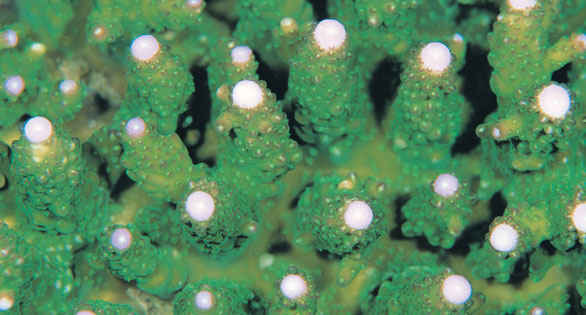
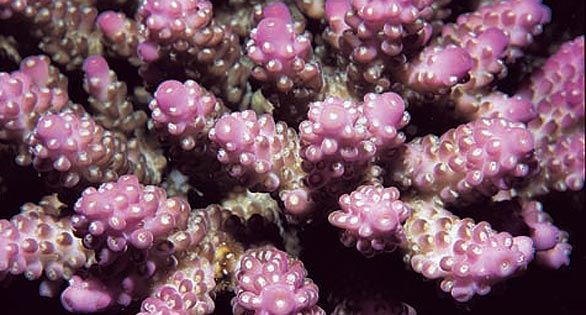

































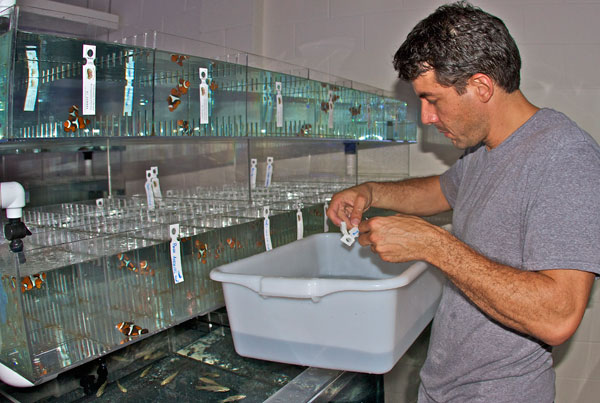 Joe Caparatta, right, told CORAL Magazine during an interview while the animals were being unpacked, “I feel that it’s important for the hobby.”
Joe Caparatta, right, told CORAL Magazine during an interview while the animals were being unpacked, “I feel that it’s important for the hobby.” 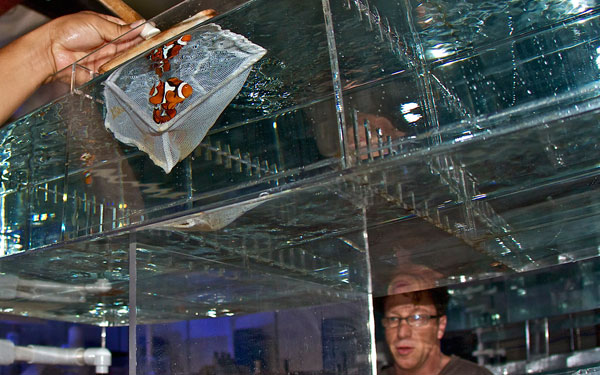
 Transparency Lacking in North American Trade
Transparency Lacking in North American Trade